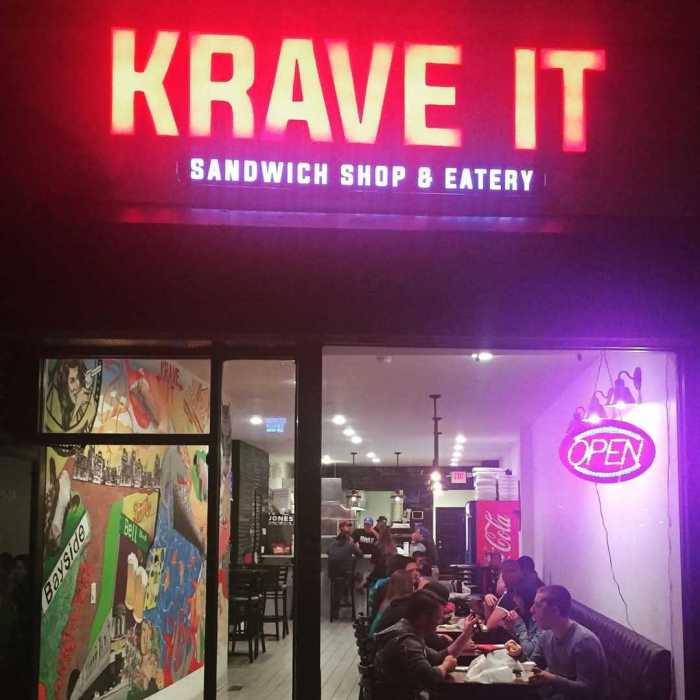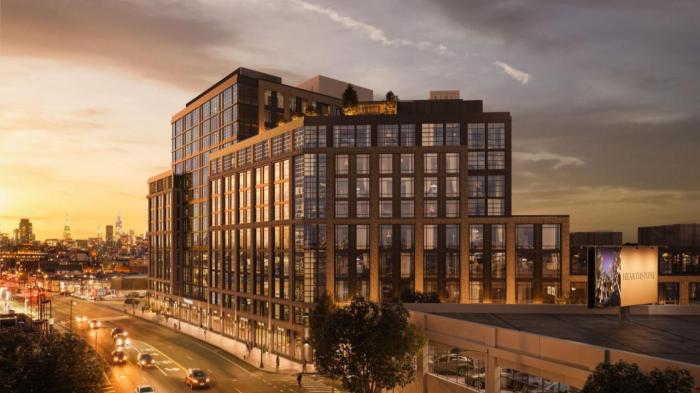There is a dream factory in Queens.
On a 15 acre site in Astoria, a group of two and three story whitewashed buildings sprawl over an area surrounded by a neighborhood of tidy, lower-middle class homes and warehouses. The buildings are not beautiful, they look functional like factories, which indeed they are. Only a series of fluttering blue flags outside indicate what product is made inside these factories. From the 1920s to this very day, the shared magic and fantasy of motion pictures have been created inside the walls of these buildings that make up the Kaufman Astoria Studios.
The buildings have been placed on the National Register of Historic Places — a distinction that no motion picture studio 3,000 miles away in Hollywood has ever received. It is a fitting distinction to a place that not only produces movie miracles, but has a history of going from days of glory to despair and back to life again that is miraculous in itself.
The studios are the centerpiece of an industry that most people rarely associate with Queens, but the fact is that this borough is Hollywood, East — a center of movie production since the earliest days of film’s silent era. In addition to Kaufman Astoria, there are two other major studios producing commercials, music videos, television programs and major motion pictures — Empire Studios and Silvercup Studios in Long Island City.
Queens also has the distinction of being the site of the very first television broadcast — President Franklin D. Roosevelt opening the 1939 World’s Fair at Flushing Meadows. So it is appropriate that Queens is home to a museum that is dedicated to the history and development of the moving image and it is open to the public as a part of the Kaufman Astoria complex.
Back in the 1920s, Paramount Pictures decided that the growing movie industry needed more than California sunshine. Designed with an eye on attracting New York’s Broadway talent, Paramount spent $2.5 million on a giant new eastern studio in Astoria. It was then — and still is — the largest sound stage outside of Hollywood. In the glory days of Astoria’s silents, Rudolph Valentino and Gloria Swanson — the biggest stars of their time — would make their way over the Queensborough Bridge in great chauffeured limousines to perform for the silver screen. Some stars, such as W.C. Fields, bought homes in Bayside to be near the studios where they filmed.
Great directors such as D.W. Griffith used the huge studio and its outdoor back lot to film dramas, comedies and spectacles. With the coming of sound in the late twenties, the studios once again proved invaluable to the motion picture industry. Claudette Colbert and Edward G. Robinson filmed one of the first talking films there. Maurice Chevalier filmed his productions in both English and French language versions and the Marx Brothers made all their early films at Astoria.
When Paramount suspended production in New York in the early thirties, independent units took over the stages. Paul Robeson filmed The Emperor Jones while Ben Hecht and Charles McArthur produced a trio of films, including The Scoundrel with Noel Coward and Sylvia Sydney starred in One Third of A Nation. With the onset of World War II, the United States Army moved in to create instructional, informational and propaganda films. Col. Frank Capra, the legendary director of "It’s A Wonderful Life" and other great films, produced the historic "Why We Fight" series there, and young actors such as Ronald Reagan made films as morale boosters for the troops. From 1942 through 1971, the army produced an average of 300 films there each year.
When the army left and the facility was closed, the great studio appeared to be at death’s door. Scavengers, working by night, stripped the building of copper wiring, brass plumbing, fittings and any other marketable material. Vandals broke all of the windows in the complex, grafitti covered the outside walls, dead birds, fallen plaster and floors filled with pools of rainwater marked the site as a ruin resembling a bombed-out city.
The rescue operation that gave this hopeless mess a new life was led by a small oddly assorted band of dreamers, doers and visionaries ranging from an aging movie queen to a union leader, a city planner, a comedian, a politician and a building developer, who all stubbornly refused to see the historic site pass into oblivion. First a cityplanner who worked in the Queens borough office was alarmed by the effect this neighborhood eyesore was having on the community. Glenn Ralston believed that not only was the abandoned studio an important piece of history but it had the potential of becoming a "phenomenal facility" for moviemaking once again. He got together with an ad-hoc bandof fellow-warriors which included John McGuire, a Screen Actors Guild executive, Larry Barr, the business representative of Motion Pictures Studio Mechanics and Sam Roberts, a former set decorator and a founder of the Council of Motion Picture and Television Unions. All felt that a major source of jobs had disappeared from the City and they enlisted the support of Claire Shulman, then the deputy to the Queens Borough President, who felt the City was also losing a major source of tax revenues.
The site was leased to the City University which thought of turning the buildings into LaGuardia Community College, but the $4.5 million in damages proved too daunting for CUNY’s management. Comedian Alan King strongly believed in the studio’s potential and he filmed a movie there with Marlo Thomas called "Thieves." But the high costs of maintance and security made further filmaking impossible. Meanwhile, Barr discovered that this piece of federal surplus property — which real estate experts said could not be replicated for less than $100 million — could be given to the City of New York for $1 if it could get official landmark status and then leased to a non-profit institution. Ralston researched the studio’s history, applied for landmark status which the National Register granted. The group then created the Astoria Motion Picture and Television Foundation, whose purpose was to be "educational." Ralston prowled local flea markets, buying up old posters, lobby cards, antique photograph equipment and other memorabilia and set up a tiny museum in a corner of the building. The unions held fundraisers and found monies in their own treasuries for start up expenses. They found local tradesmen — plumbers, roofers, trash collectors — who did work and were willing to wait for payment. Larry Barr ran the studios operation without pay and Sam Roberts set up an office there.
Gloria Swanson, who literally fled Hollywood in the 1920s claiming an illness required treatment in New York , had loved working in Astoria. She wrote in her biography that "the place was full of free spirits, defectors, refugees, who were all trying to get away from Hollywood and its restrictions. There was a wonderful sense of revolution and innovation in the studio in Queens." Swanson, frail and in her 80s, became a staunch supporter of a revived studio and even while it was still a wreck she would make regular visits to be ushered around the vast studio by Barr because he said, "she just wanted to walk around the stages where she said ‘she grew up.’" Swanson agreed to be the main guest at the gala fundraising dinner that was held right on the main soundstage in 1977.
But it wasn’t until director Sidney Lumet chose to make his $24 million musical "The Wiz" there in 1978 that the credibility of the site as a viable production center was made (see adjacent story). The movie pumped in money to build dressing rooms and rebuild other blighted areas. "The Wiz" brought in a steady stream of first class films including Hair, Arthur, All That Jazz, Going In Style, among others. But in order to keep business going a massive infusion of funds would be needed for renovation and modernization.
The City found a New York developer, George Kaufman, to take over the complex and he proceeded to rebuild the studios adding state of the art recording studios and radio facilities. The original foundation and its tiny museum restructured as the American Museum of the Moving Image and under the direction of Rochelle Slovin, turned one of the empty warehouses into the world-class museum it is today.
Francis Ford Coppola, Woody Allen and other major directors constantly use the Astoria Studios and the stars of the big screen are once again daily visitors to the great sound stages. Sesame Street is taped there and Bill Cosby tapes his hit sitcom "The Cosby Show" before a live studio audience at Astoria every Thursday. WFAN has its radio studios there also with Don Imus broadcasting his national morning program from there.
The story of the Astoria Studios with its historic past and its present status as "Hollywood East" proves that dreams are not only played out in the movies. They happen right here in the streets of Queens.



































